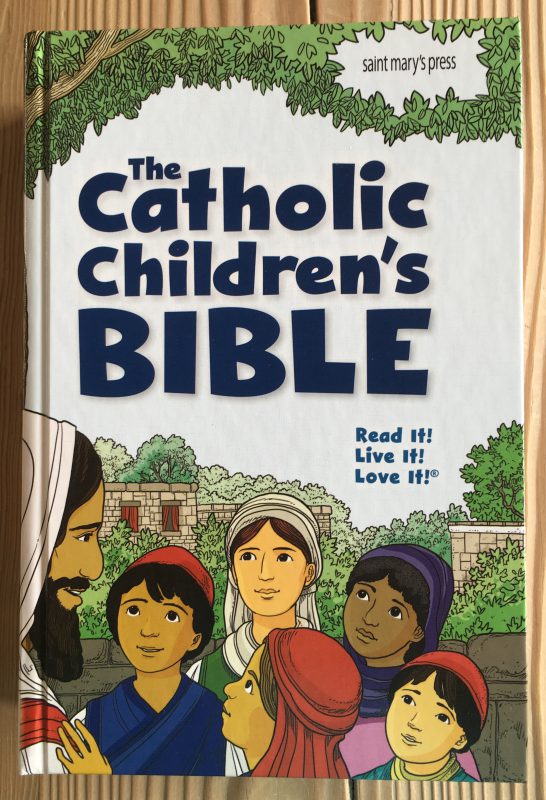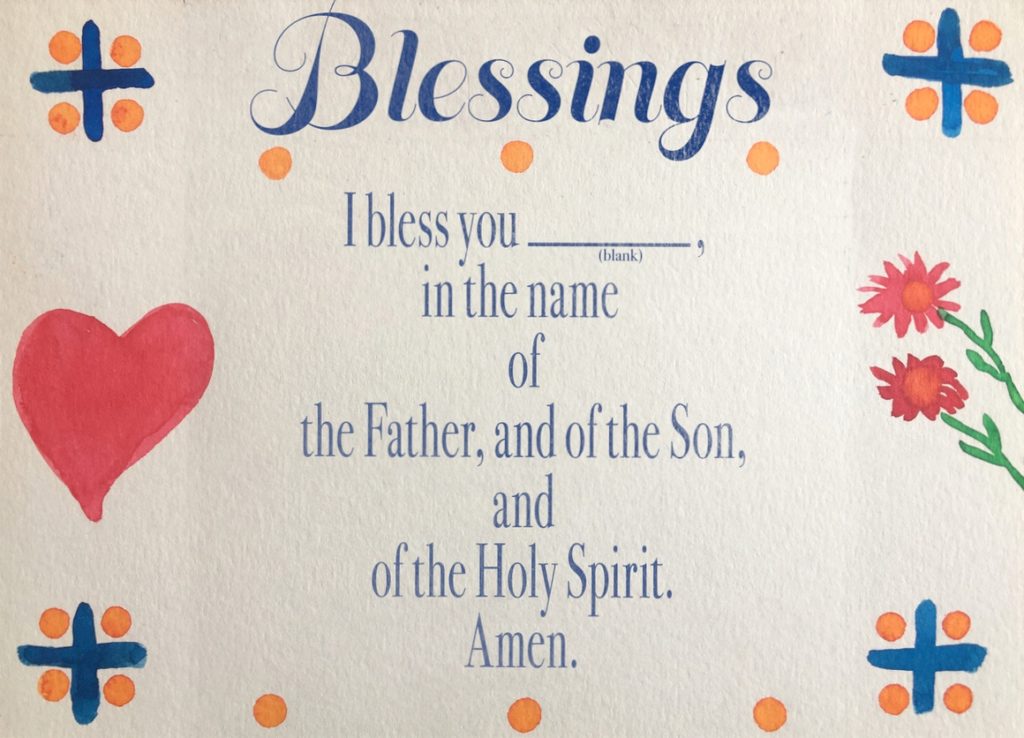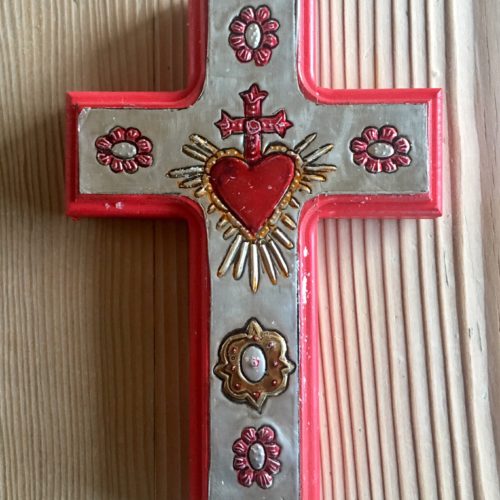“The Church Is One, Holy, Catholic, and Apostolic”
“The Church is one: she acknowledges one Lord, confesses one faith, is born of one Baptism, forms only one Body, is given life by the one Spirit, for the sake of one hope (cf. Eph 4:3-5), at whose fulfillment all divisions will be overcome.”
Source: Catechism of the Catholic Church “The Profession of Faith”
For Parents to Teach to Their Children
“One Bread, One Body”
Our Prayers
“The Apostles’ Creed” An ancient profession of faith, that states what we as Catholics believe:
Grace Before Meals
“Bless us, O Lord, and these your gifts,
which we are about to receive from your bounty,
through Christ our Lord. Amen.”
Source: The Catholic Children’s Bible, Page 1993

We Bless Ourselves with the Sign of the Cross
“In the Sign of the Cross, we profess the deepest mysteries of the Christian Faith: the Trinity—Father, Son, and Holy Spirit–and the saving work of Christ on the Cross on Good Friday. The combination of the words and the action are a creed—a statement of belief. We mark ourselves as Christians through the Sign of the Cross.
And yet, because we make the Sign of the Cross so often, we may be tempted to rush through it, to say the words without listening to them, to ignore the profound symbolism of tracing the shape of the Cross—the instrument of Christ’s death and our salvation—on our own bodies. A creed is not simply a statement of belief—it is a vow to defend that belief, even if it means following Our Lord and Savior to our own cross.”
Source:ThoughtCo.com “How (and Why) Catholic Make the Sign of the Cross”
“Place the left hand extended under the breast. Hold the right hand extended also. At the word Patris [Father] raise it and touch the forehead; at Filii [Son] touch the breast at a sufficient distance down, but above the left hand; at Spiritus Sancti [Holy Spirit] touch the left and right shoulders; at Amen join the hands if they are to be joined.”
Source: CatholicEducation.org “The Sign of the Cross”
A Blessing for Families–We Ask for God’s Blessing
“You and your family members can bless each other too! To bless someone, make a cross on the person’s forehead with your thumb. Here is a blessing prayer to say while you make the Sign of the Cross: ‘I bless you, [Say the person’s name], in the name of the Father and of the Son, and of the Holy Spirit. Amen.’ You and your parents can use this blessing at bedtime to bless each other.”
Source: The Catholic Children’s Bible “Live It!” Page 61
How and Why We Genuflect
We genuflect to show reverence, respect, love, and humility. Children learn by watching their parents and older siblings. However, a little instruction and practice is important, too. Children seven-years-old and younger are a bit wobbly when they try to genuflect for the first time. Little children can try this in “baby steps” until, over the years, they can touch their knee to the floor. They need a hand for support when learning how to bend their right knee to the ground. Historically, if we would meet a bishop or a pope we would bend our left knee and would kiss their ring before receiving a blessing. It is less common today. When a person does genuflect before a bishop or a pope, it is an acknowledgement of the office of bishop or pope and not the person. It is also a sign of love and respect for Jesus through the office of the bishop or the pope.
Source: CatholicAnswers.com “Forum”
“This [Genuflexion]is peculiar to the Roman Rite, and consists in the momentary bending of one or both knees so as to touch the earth.”
“All genuflect (bending both knees) when adoring the Blessed Sacrament unveiled, as at Expositions.
All genuflect (bending the right knee only) when doing reverence to the Blessed Sacrament, enclosed in the Tabernacle, or lying upon the corporal during the Mass. Mass-servers are not to genuflect, save when the Blessed Sacrament is at the altar where Mass is being said (cf. Wapelhorst, infra). The same honour is paid to a relic of the True Cross when exposed for public veneration.
The clergy in liturgical functions genuflect on one knee to the cross over the high altar, and likewise in passing before the bishop of the diocese when he presides at a ceremony. From these genuflexions, however, an officiating priest, as also all prelates, canons, etc., are dispensed, bowing of the head and shoulders being substituted for the genuflexion.
On Good Friday, after the ceremony of the Adoration of the Cross, and until Holy Saturday, all, clergy and laity alike, genuflect in passing before the unveiled cross upon the high altar.”
Source: NewAdvent.org “Genuflexion”
We Are Respectful in Church
Advice from Robb Stout, a parent of five:
“Dress up for Church. Children know that you always dress up when you go to something important. Whenever you have important visitors to your home you dress up. When you go to your boss’ house for dinner, you dress up. When you go to the House of God, you wear shorts and a tee-shirt. Unless your children are incredibly stupid, they are going to attach the appropriate level of importance to God. Church is a special place.”
“Always, always, always genuflect and remind each child as they enter the pew to genuflect to the tabernacle. If you genuflect and they genuflect, even when no one else is doing it, they will feel less self-conscious about it as they get older.”
Source: CatholicEducation.org “Kids in Church”
Our Readings
Reading for Grown-ups
Source: USCCB.org 1 CORINTHIANS Chapter 12 “One Body, Many Parts.”
12
As a body is one though it has many parts, and all the parts of the body, though many, are one body, so also Christ.g
13
For in one Spirit we were all baptized into one body, whether Jews or Greeks, slaves or free persons, and we were all given to drink of one Spirit.h
14
Now the body is not a single part, but many.
15
If a foot should say, “Because I am not a hand I do not belong to the body,” it does not for this reason belong any less to the body.
16
Or if an ear should say, “Because I am not an eye I do not belong to the body,” it does not for this reason belong any less to the body.
17
If the whole body were an eye, where would the hearing be? If the whole body were hearing, where would the sense of smell be?
18
But as it is, God placed the parts, each one of them, in the body as he intended.
19
If they were all one part, where would the body be?
20
But as it is, there are many parts, yet one body.
21
The eye cannot say to the hand, “I do not need you,” nor again the head to the feet, “I do not need you.”
22
Indeed, the parts of the body that seem to be weaker are all the more necessary,
23
and those parts of the body that we consider less honorable we surround with greater honor, and our less presentable parts are treated with greater propriety,
24
whereas our more presentable parts do not need this. But God has so constructed the body as to give greater honor to a part that is without it,
25
so that there may be no division in the body, but that the parts may have the same concern for one another.
26
If [one] part suffers, all the parts suffer with it; if one part is honored, all the parts share its joy.
Reading for Children
Excerpts from 1 Corinthian 12 “One Body and Many Parts”
Source: The Catholic Children’s Bible “One Body and Many Parts” Pages 1806-1807
“12 Christ is like a single body, which has many parts; it is still one body, even though it is made up of different parts. 13 In the same way, all of us, whether Jews or Gentiles, whether slaves or free, have been baptized into one body by the same Spirit, and we have all been given one Spirit to drink.”
“18 As it is, however, God put every different part in the body just as he wanted it to be. 19 There would not be a body if it were all only one part! 20 As it is, There are many parts but one body.”
“25 And so there is no division in the body, but all different parts have the same concern for one another.”
“27 All of you are Christ’s body, and each one is a part of it.”
Our Writing Project–“One, Holy, Catholic, Apostolic”
These words are called, “The Four Marks or Attributes of the Church.”
Gather writing tools, paper, stickers, and colorful masking tape. Make the number “1” in masking tape or draw one on the paper. Write words from our readings onto the paper: One, God, Lord, Holy, Spirit, Faith, Church, Baptism, Body, Catholic, Apostolic, and Hope. Decorate as desired. Young children can write a few of the shorter words.
Our Art Project–A Colorful Cross

For a beautiful, quick and easy art project, use water soluble pastels, watercolor paper, and a cross to trace. If a cross that fits the paper isn’t available, make a template from any heavy paper–old greeting cards, index cards, or other paper scraps–or use painter’s tape that is easily peeled off to make a cross outline. I used the wooden cross pictured below because it was handy and served as my model for the drawing. Next, use colors to go around the outline of the first color. Then, smudge the pastels using a finger. Invite your child to draw inside the white cross outline or as they wish. Watercolors would be lovely on the blank paper around the cross drawing. This is a fast and fun project for all ages.
Source: HousingAForest.com
Our Materials
Suggested Homework Activities
Invite your family members to practice “The Golden Rule” at home and at school.
“Do for others what you want them to do for you.” (Matthew 7:12)
Please read with your child: “Adam and Eve–The Garden of Eden” in Genesis 2:5-25 from your family Bible or a Catholic Children’s Bible. Click on the link to the story from the USCCB.org.








